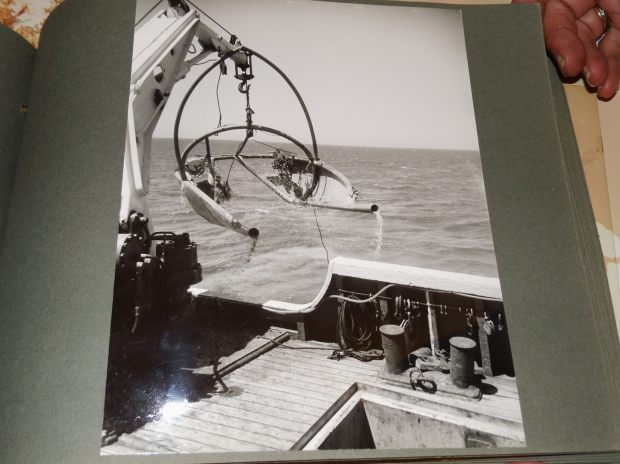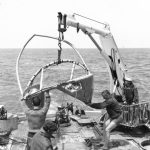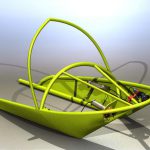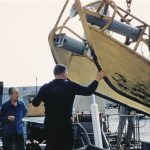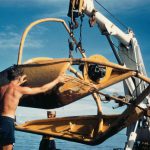La troïka
Au travers de cette page , je vais essayer devous faire découvrir un appareil des plus étrange, des plus laid, si cela est possible de dire. Un engin inerte, mais capable de ce poser sur le fond du plateau continental et après avoir été tracté par Calypso, rejoindre la surface en s'étant joué de tous les pièges que le fond marin pouvait lui présenter.
Pourquoi créer la Troïka:
L'idée vient à JYC après plusieurs tentatives infructueuses de prendre des clichés de la vie animal dans le fond des abyss?
A bord de la Calypso, ils ont réalisé plus de 800 photos par -8000 m de profondeur, mais l'utilisation d'un apparel fixe induit indubitablement sur la vie animal local. L'utilisation répété d'un flasch pour réaliser ces clichés maintient la vie animal des profondeur, pas habituée à la lumière hors du champs lumineux indispensable pour la réalisation des clichés.
L'été 1957, à bors de Calypso, JYC et ses hommes réalisèrent comme ils le pouvaient leurs premier traineau russe. pour ce faire, ils utilisèrent une des échelle de plongée de Calypso , à laqu'elle ils courbèrent les extrémitée d'un seul bout. Dessus fut fixé par le professeur Harold Hédgerton l'un de ces appareil photos équipé d'un de ces flasch. Le capitaine François Saout, fixa lui même le drapeau du National Géographic ainsi qu'un petit morceau de paier ou l'écrivain du bord ames Ducan avait inscrit « RIP », car aucun des membres de la Calypso ne pesaient revoir l'étrange engin ni les appareils qui y étaient fixés.
La réussite et le résulta des clichés prit fit prendre conscience à Cousteau du véritable devenr de cette étrange engin et de ces nombreuses utilisations dans l'étude des grands fonds.
De retour à Marseille, JYC s'empressa de prendre contact avec son équipe de scientifiques installé a cette époque dans les locaux de l'OFRS. C'est sous la direction du Commandant Alinat et de l'ingénieur André Laban que fut creer, imaginé et réalisé ce qui devient la TROÏKA.
Les documents qui vont suivre, mon été fourni par Mr Patrick Roux, fils de Mr Jean Charles Roux , véritable maquétiste et concepteur de génie qui oeuvra avec JY Cousteau durant de très longue années. je vous invite donc à découvrir la page que je lui consacre sur se site.
The troika
Through this page, I will try devous to make discover the device of strangest, uglier, if that is possible to say. A machine inert, but able this to pose on the bottom of the continental shelf and after being tractor drawn by Calypso, to join surface while being played of all the traps which the seabed could present to him.
Why create the Troika:
Does the idea come with JYC after several unfruitful attempts to take stereotypes of the life animal in the content of the abyss?
On board Calypso, they realized more than 800 photographs by -8000 m of depth, but the use of a apparel fixes undoubtedly induced on the life local animal. The use repeated of a flasch to carry out these stereotypes maintains the life animal depth, not accustomed to the light out of luminous fields essential for the realization of the stereotypes.
The summer 1957, with bors of Calypso, JYC and its men realized as they could it their first Russian sledge. with this intention, they used one of the scale of diving of Calypso, with laqu' it they curved extrémitée of only one end. Above was fixed by professor Harold Hédgerton one of these camera equipped with one of these flasch. The captain François Saout, fixed to him even the flag of National Geographic as well as a small piece to pay or the writer of the edge Ducan hearts had registered “RIP”, because none the members of Calypso weighed to re-examine the strange machine nor the devices which were fixed there.
The success and resulted it from the stereotypes took made become aware with Cousteau of true the devenr of this strange machine and these many uses in the study of deep seas.
Of return to Marseilles, JYC hastened to get in touch with its team of scientists installed has this time in the buildings of the OFRS. It is under the direction of the Commander Alinat and engineer André Laban that was to create, imagined and carried out what becomes the TROIKA.
The documents which will follow, my summer provided by Mr. Patrick Roux, son of Mr. Jean Charles Roux, true genious maquetist and originator which worked with lasting JY Cousteau of very long years. I thus invite you to discover the page that I devote to him on site.
La Troïka est faite d'une structure tubulaire longue de 4 mètres et large de 1.5 mètre.
L'arceau de redressement s'élévait à 1 mètre.
Elle se déplaçait obliquement , un peu comme un crabe( ainsi le sable soulevé par son mouvement ne venait pas obstuer le champs de vision soit des appareils photos soit des caméras fixées)
Elle était équipée de 2 gros projecteurs ou flaschs
Elle était tirée grâce à un cable. lorsqu'elle butait ou venait a ce coincée; on augmentait à bord de la Calypso la tension du câble de remorque, qui se détachait alors de l'avant pour rester fixé à l'arrière. Ainsi la stoïka se dégageait de l'obstacle et ppouvait être récupérée.
The arch of rectification amounted to 1 meter.
It moved obliquely, a little as a crab (thus the sand raised by its movement did not come to block the fields of view either of the cameras or of the fixed cameras)
It was equipped with 2 large projectors or flashes
It was drawn thanks to a cable. when it butted or came this wedged; one increased on board Calypso the tension of the cable of trailer, which was detached then from before remaining fixed in the back. Thus the stoïka was released from the obstacle and could be recovered.
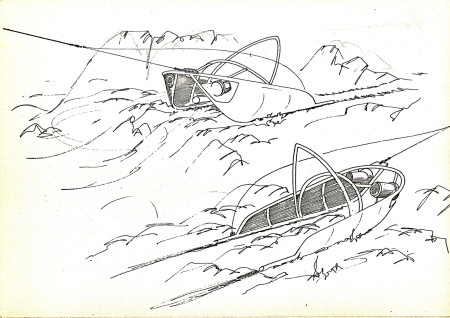
1958 fut l'année ou furent réalisé les premiers essaies des Troikas
